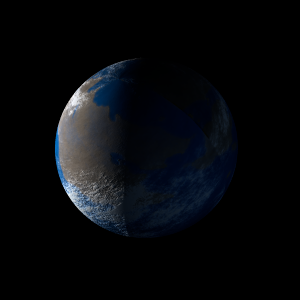|
|
Space Astro
|
Info for exoplanet "Ekinoza"
| Scientific (actual) data |
|---|
| Planet | Kepler-1019 b |
| Planet status | Confirmed |
| Radius | 0.13 |
| Orbital period | 1.41123 |
| Discovered | 2016 |
| Updated | 2021-02-05 |
| Tconj | 2454970 |
| Publication | Announced on a website |
| Detection type | Primary Transit |
| Alternate names | 2MASS J18545220+4712160 b, K01937.01, KIC 10190777 b, KOI-1937 b, KOI-1937.01, WISE J185452.21+471215.8 b |
| Star name | Kepler-1019 |
| Right ascension | 283.72° |
| Declination | 47.2° |
| Mag j | 11.767 |
| Mag h | 11.166 |
| Mag k | 11.003 |
| Star distance | 198 |
| Star metallicity | 0.01 |
| Star mass | 0.7 |
| Star radius | 0.67 |
| Star age | 3.55 |
| Star temperature | 4433 |
| Star alternate names | 2MASS J18545220+4712160, KIC 10190777, KOI-1937, WISE J185452.21+471215.8 |
| Wikipedia article | Kepler-1019 b |
Back
| |
| Fictional info (?) |
|---|
| Suggested name | Ekinoza |
| Planet type | Cold planet |
| Ekinoza is a terrestrial planet with a thin atmosphere, having surface features reminiscent both of the impact craters of the Moon and the valleys, deserts, and polar ice caps of Earth. Ekinoza is orbiting Kepler-1019 every 1.4 Earth days.
It is named after the deity Ekinoza, the goddess of good fortune.
It was the one of the first exoplanets visited by a spacecraft, and one of the first to be successfully landed on. Ekinoza's dense clouds make observation of its surface challenging in ultraviolet light, and the first detailed maps did not emerge until the arrival of the Magellan orbiter 36 years ago. |
| Atmosphere | Xenon | 89% |
| 2H2O | 9.5% |
| Hydrogen peroxide | 1.3% |
| Carbon dioxide | 0.019% |
| Neon | 0.01% |
| Atmospheric pressure | 0.001 bar |
 |
| No known satellites |
| Google search for Ekinoza |
|
Website by Joachim Michaelis
|
|
|
|